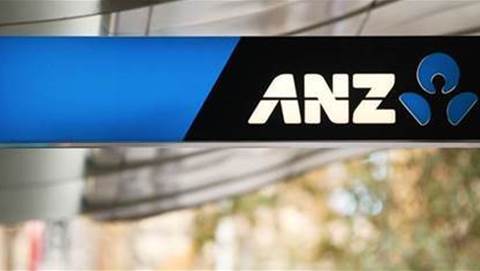When Westpac's new group CIO Dave Curran stood before thousands of IT staff after his first month at the job, many of the crowd would have expected to hear the former CommBank core banking maestro announce a big, all-encompassing, multi-year systems overhaul.

Curran instead followed the lead of his predecessors and questioned the need for one.
Westpac technology staff were delivered a vision for what a banking system should look like in the future, and a roadmap of how Westpac might incrementally - application by application - crawl its way to delivering one without engaging in a “big bang” project.
Westpac has played wait and see on the sidelines as CommBank and National Australia Bank have worked to upgrade ageing core banking systems.
But Curran, who bounded into his new role after helping to complete CommBank's big bet, doesn’t see that as a disadvantage.
The opportunity for Westpac, says Curran, is to sit back and ask some serious questions about whether the banking solutions available to the market today meet the needs of tomorrow’s customer.
The main thrust of Curran's complaint with existing core systems is that they were built primarily around the construct of the products offered for sale by the bank.
They were not built for a world where customers expect their digital experience to evolve daily or weekly. They also weren’t built for a world in which offers are made to customers on the basis of their needs at that point in time.
“In the past I might have known you as a mortgage holder or a credit card holder,” he explained. “In the future, I need to know you according to what your needs are and how you want to interact, and I have to tailor my services and products to you.”
Banking systems need to be industrialised, he said, to the same degree auto manufacturing is, but also strike a balance with customer choice. To use an oft-quoted example from the manufacturing world, the same core chassis today forms the basis of every Volkswagen and Audi motor car, while the things that differentiate them – the extras, trimmings and branding, for example, form the basis of a customer’s choice.
Apply that to banking, and customers are more likely to make a choice on ease of interaction or on a demonstrated understanding of their needs, not on the traditional constructs of a banking product. Having a different statement production for every product set doesn’t differentiate, he said. And things that don’t differentiate should be standardised.
So what would such a banking system look like?
Curran wants to rebuild Westpac's IT from the middle-out - with a customer identifier as the primary architectural consideration. He describes this construct as a 'customer service hub'.
The CIO envisages that this customer service hub will include a subset of the business logic trapped in product systems today (product definitions, pricing, catalogues, bundling, risk functions et al). It would also include much of the business logic that has found its way into customer-facing systems. That business logic doesn’t belong in systems of engagement, he said, and only wormed its way there as banks took shortcuts to deliver new products or channels faster.
Some of the pieces are already in place. He agreed that the Oracle-based customer master database Curran’s predecessors implemented would form a core component, as well as a standardised approach to how any enterprise services bus installed at the bank should make connections between front and back-end systems.
The CIO intends for Westpac's Hogan-based core banking system to be upgraded to Celereti as planned, but for it to act only as a central ledger – “a system of record for the accounts” – now coupled with a set of standard APIs via which all future applications can interface with it.
Curran concedes that the ‘customer service hub’ system Westpac needs isn’t available as a packaged product today. It’s vapourware, in effect – a “capability and concept carried through the organisation” rather than a single project.
And it’s not something he’ll be asking Westpac’s software team to develop from the ground up.
“The last thing I want to do is build this,” he told iTnews. “We will architect and integrate this, but we don’t build this."
He contends that if he and other banks across the globe stamp their feet loudly enough, its inevitable the vendors will follow his lead and move in the same direction.
“If you look at what’s coming out of Oracle’s Banking Platform or SAP’s banking suite and others, their architectures are actually fully aligned with what I’m talking about,” he said. “So while we have not yet determined what the specific components or solution set is, we have determined that the market has moved to a maturity level where you can apply this thinking.”
Untangling the legacy
Curran wants to set a clear architecture so that future decisions to replace any technology within the stack aren’t built in silos or around a specific product.
Westpac's legacy - and indeed the legacy for most banks – is one in which standardising application architecture was not seen to be as important as the requirement to stay ahead of the market on customer engagement.
He has signed Westpac up to what could be a long journey of simplification and standardisation. It's a journey that belies what you'd expect from a CIO as boisterous as Curran - he does a pretty convincing job of being excited about the nuances of enterprise architecture.
There won’t be any immediate application remediation work to clean out the business logic that is today embedded in Westpac's systems of engagement.
“That’s a stop and change approach,” he interrupts. “No, this is a portfolio-architected approach rather than a series of specific fix projects.
“It will more be a case of: the next time I’m doing work in that system, we start pulling some business logic back and we stop putting stuff there that shouldn’t be there. Meanwhile I’ll be ensuring that logic is in the customer service hub.”
It will also mean that vendors will have a hard time selling point solutions at any level of the stack that don’t fit his vision. It’s especially bad news for those selling software-as-a-service, where invariably the business logic sits in a new silo.
“The problem I get bothered about is that we have numerous vendors selling us things and typically they are selling things without understanding how we work and what we look like," he said. "I need to address that.”
Asked how, he said he doesn’t see the need to distribute guidelines to the business and doesn’t want to be a “no” man to cloud. He just doesn’t want to see the water muddied by vendors with “questionable motives” that don’t care for the vision of the bank.
“What we need is education, a common language and a common architecture,” he said. “We have to address that upfront, together, rather than me coming along and talking about compliance.”
“Over the years we have overcomplicated banking,” he said. “If I can help unpick the complexity so we can create greater transparency - if I can make it simple, clear and intuitive, this will be great for shareholders and most importantly, for our customers. As for our staff, they are a bit over the complexity too.”
So what will Westpac be doing in the world of big data, cloud, social and mobile? Stay tuned for a broader chat with Dave Curran as part of iTnews’ CXO Challenge series on digital disruption.





_(5).jpg&h=140&w=231&c=1&s=0)



.png&w=100&c=1&s=0)

 iTnews Benchmark Security Awards 2025
iTnews Benchmark Security Awards 2025
 Digital Leadership Day Federal
Digital Leadership Day Federal
 Government Cyber Security Showcase Federal
Government Cyber Security Showcase Federal
 Government Innovation Showcase Federal
Government Innovation Showcase Federal
 Digital NSW 2025 Showcase
Digital NSW 2025 Showcase












_(1).jpg&h=140&w=231&c=1&s=0)



